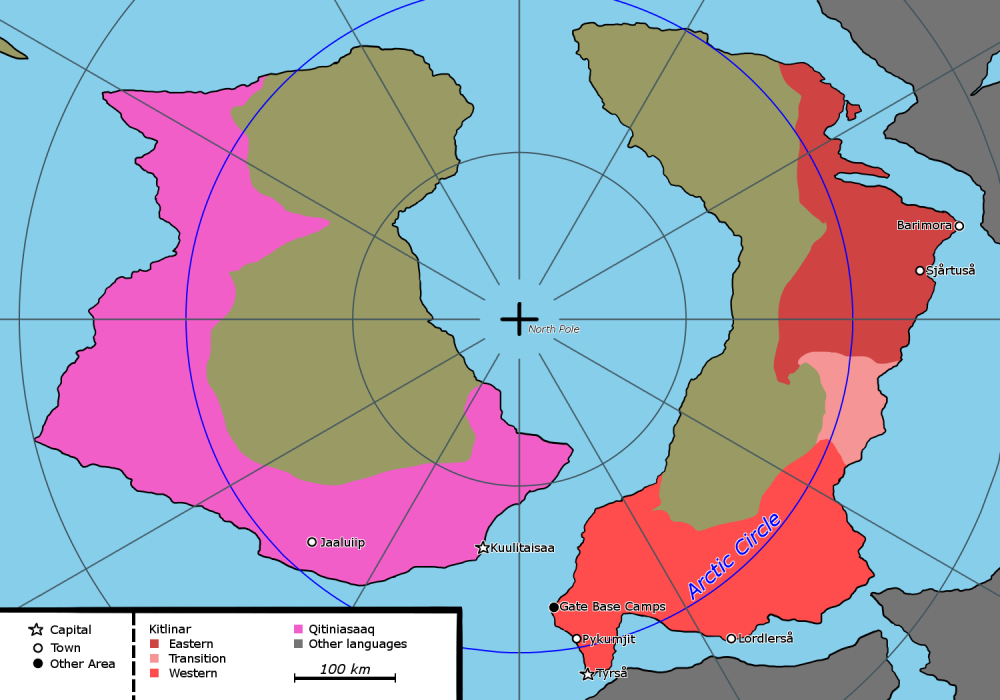Originally posted on Wordpress on 12 July 2021
Background & Introduction
I created Qitiniasaaq in 2016, sometime after I'd created Kitlinar. It's less complete than Kitlinar, since the first version of The Gate at the End of the World only had one Qitiniina character and the Qitiniasaaq language wasn't spoken.

I never bothered creating any specific dialects for it like I did with Kitlinar, even though it'd likely have many more dialects. I guess what I'm describing here is the Kuulitaisaa dialect.
You may have assumed that this language has some phonological and orthographical influences from the Inuit languages, and you'd be correct. It also has some inspirations from Finnish - primarily in the number of cases it has.
Consonants
[ɴ] is an allophone of /n/ and only occurs at the end of words.
| Labial | Alveolar | Palatal | Velar | Uvular | |
|---|---|---|---|---|---|
| Nasal | m | n | ŋ | (ɴ) | |
| Stop | p | t | k | q | |
| Fricative | s | ||||
| Approximant | l | j |
Vowels
Vowels are either long or short. Diphthongs are the same.
| Front | Back | |
|---|---|---|
| Close | i iː | u uː |
| Open | a aː |
Syllable Structure and Stress
Syllable structure is CVC, where:
- C = any consonant
- V = any vowel or diphthong
The majority of syllables are CV, with CVC syllables mainly occurring word-finally.
Primary stress usually falls on syllables with long vowels.
Orthography
| Letter | a | aa | i | ii | j | k | l | m |
| Sound | /a/ | /aː/ | /i/ | /iː/ | /j/ | /k/ | /l/ | /m/ |
| Letter | n | ng | p | q | s | t | u | uu |
| Sound | /n/ | /ŋ/ | /p/ | /q/ | /s/ | /t/ | /u/ | /uː/ |
Pronouns
Qitiniasaaq didn't even have any pronouns until I started cleaning up all my notes a couple of months ago. That's how little grammar I made for this language - it's basically a glorified naming language!
As a result, the pronoun system is fairly standard and boring:
| Person | Singular | Plural |
|---|---|---|
| 1st | liin | liinik |
| 2nd | sana | sanamik |
| 3rd | main | mainik |
Nouns
Nouns are marked for case & number. They can also take on a demonstrative determiner as an interfix. Adjectives are fused onto the end of the noun, and any noun can be used as an adjective without any modification - til can mean both "ice" and "icy".
Short phrases formed with the genitive case tend to become one word, such as qitiniasaaq "tundra's language". This is broken down into qitin "tundra" + ia "genitive" + saaq "language".
Qitiniasaaq is also ergative-absolutive instead of nominative-accusative like most of my languages - another major influence from the Inuit languages.
| Case | Singular | Plural |
|---|---|---|
| Ergative | -kaa | -kaamik |
| Absolutive | - | -(m)ik |
| Genitive | -ia | -iamik |
| Dative | -inuu | -inuumik |
| Comitative | -pi | -pimik |
| Instrumental | -qui | -quimik |
| Abessive | -miu | -miumik |
| Ablative | -tau | -taumik |
| Allative | -kaai | -kaaimik |
| Adessive | -laa | -laamik |
| Inessive | -qu | -qumik |
| Elative | -sau | -saumik |
| Illative | -naa | -naamik |
Verbs
Verbs are declined for tense, mood, and voice. They aren't declined for person, but pronouns can be stuck onto the end of the verb.
- Tenses: far past, past, near past, present, present habitual, near future, future, far future
- Moods: indicative, conditional, imperative
- Voice: active, passive
I think Qitiniasaaq is the first language where I made a distinction between near & far past/future tenses. That's something I've used in other conlangs I've created since 2016.
Not all conjugations in the table below exist - I haven't yet figured out which ones don't:
| Far past | Past | Near past | Present | Present habitual | Near future | Future | Far future | |
|---|---|---|---|---|---|---|---|---|
| Indicative (Active) | -timi | -mi | -kami | - | -lii | -katuu | -tuu | -tituu |
| Indicative (Passive) | -timisa | -misa | -kamisa | -sa | -liisa | -katuusa | -tuusa | -tituusa |
| Conditional (Active) | -timimiiq | -mimiiq | -kamimiiq | -miiq | -liimiiq | -katuumiiq | -tuumiiq | -tituumiiq |
| Conditional (Passive) | -timimiiqsa | -mimiiqsa | -kamimiiqsa | -miiqsa | -liimiiqsa | -katuumiiqsa | -tuumiiqsa | -tituumiiqsa |
| Imperative (Active) | -timikui | -mikui | -kamikui | -kui | -liikui | -katuukui | -tuukui | -tituukui |
| Imperative (Passive) | -timikuisa | -mikuisa | -kamikuisa | -kuisa | -liikuisa | -katuukuisa | -tuukuisa | -tituukuisa |
Here's an example of the passive/active voice:
Kaalaliiliin Qitiniasaaq.
- I speak Qitiniasaaq.
- speak.PRS-HAB.IND.ACT.1SG Qitiniasaaq.ABS
Kaalaliisaliin Qitiniasaaq.
- Qitiniasaaq is spoken by me.
- speak.PRS-HAB.IND.PASS.1SG Qitiniasaaq.ABS
Resemblance to the Greenlandic Inuit word "kalaallisut" is entirely coincidental. Seriously!